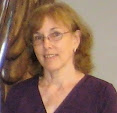 Our group was mixed in terms of education (from preliterate to semiliterate) and age (teen to middle age). The class wanted to gain literacy in English, not in the language we all were speaking to each other (Krio).
Our group was mixed in terms of education (from preliterate to semiliterate) and age (teen to middle age). The class wanted to gain literacy in English, not in the language we all were speaking to each other (Krio). Our problem was community-based beginning reading materials in English. Could a beginning literacy class prepare a book, not knowing how to read? By cooking in Sierra Leone one develops a sharp eye for identifying different kinds of leaves.
 I brought a lot of cooking leaves in to class one day, and we spread them out on the table.
I brought a lot of cooking leaves in to class one day, and we spread them out on the table.  Before more than a few moments had passed, I realized the conversation had moved from cooking to medicine! This was a better topic, because although we all knew how to prepare the same dishes, each one of us had different herbal knowledge to share. To my surprise, many of the women had admired the rich assortment of useful herbs in the SELI compound as they had come and gone from classes. We all went out collecting. Here you see four leaves that we found: mango (common), fig nut, guava, and sour sop.
Before more than a few moments had passed, I realized the conversation had moved from cooking to medicine! This was a better topic, because although we all knew how to prepare the same dishes, each one of us had different herbal knowledge to share. To my surprise, many of the women had admired the rich assortment of useful herbs in the SELI compound as they had come and gone from classes. We all went out collecting. Here you see four leaves that we found: mango (common), fig nut, guava, and sour sop.In subsequent classes I taped these discussions, and recorded who offered each bit of herbal knowledge.
 We agreed on short medicine-preparing recipes. I recorded them in English and printed up a booklet which I brought to class and pantomimed my problem. I'm sick, and I need to find the right recipe! How should we organize the book so I can find what I need quickly?
We agreed on short medicine-preparing recipes. I recorded them in English and printed up a booklet which I brought to class and pantomimed my problem. I'm sick, and I need to find the right recipe! How should we organize the book so I can find what I need quickly?  We talked about organizing it by the suggestor's name, by the leaf, or by the sickness, and they decided it would be most useful to organize by the sickness. In that session, we drew up our table of contents, and settled on Keep Well as a good title.
We talked about organizing it by the suggestor's name, by the leaf, or by the sickness, and they decided it would be most useful to organize by the sickness. In that session, we drew up our table of contents, and settled on Keep Well as a good title.Couldn't we draw on students' acute visual leaf discrimination skills to enhance literacy learning in a community-based project? What if we drew up a beginning literacy book in which each letter had a different array of + or - distinctive features? It would be far less complicated than what they use every day for recognizing leaves: shine, curvature, veining, hue, shape, margin, texture. . .!
Student goals changed in these few months. Some who'd said their main goal was to learn to write their names, now could see a future when they could read a book they had written. They were all sorry to see the end of this project. Learning had become a possible and important thing for them, and they did not want to give it up.

No comments:
Post a Comment
We look forward to hearing from you!